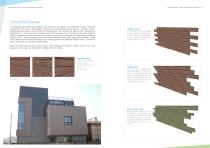 Website:
ASTURIANA DE LAMINADOS
Website:
ASTURIANA DE LAMINADOS
Catalog excerpts

Façade Cladding systems overview Angle standing seam
Open the catalog to page 1
Cladding systems – angle standing seam for façades | 3 Sistemas de revestimiento - Junta alzada para fachadas Index Main characteristics Principal joints Horizontal layouts Vertical layouts Substrates and façade construction
Open the catalog to page 2
4 | Cladding systems – angle standing seam for façades Cladding systems – angle standing seam for façades | 5 Main characteristics The system is suitable for flat and curved façades. It is a traditional system that continues to be popular for façade cladding due to its attractive appearance, modest price and ease of installation. Its principal joint, subtle but well defined, transmits elegance, lightness and ‘direction’ to the building it protects. It is a very durable, light-weight wall construction that requires virtually no maintenance. Installed in a vertical or horizontal direction,...
Open the catalog to page 3
6 | Cladding systems – angle standing seam for façades Cladding systems – angle standing seam for façades | 7 Principal joints The longitudinal joint is an adaptation of the standing seam used in roofing. In fact, it is the same joint save for being finished with a 90º fold instead of the 180º fold used in roofing (for increased weatherability), to form a 25mm upstand with a 12mm flange Finishing the joint in this way gives three advantages for façade work: • The metal is not stressed as much producing flatter trays • It presents a stronger and more uniform joint width • The joint is more...
Open the catalog to page 4
8 | Cladding systems – angle standing seam for façades Appearance The standing seam gives direction to the cladding and the orientation of the seams is therefore an important consideration for the architect. The seams themselves are fairly fine, but in sunny weather the shadows they cast are clearly visible on the façade. Normally the seams are set either vertically or horizontally, although occasionally they are set at angle somewhere in between for design reasons. Vertical trays can be quite long, but horizontal trays are normally limited to 3m to keep their handling on site reasonably...
Open the catalog to page 5
10 | Cladding systems – angle standing seam for façades Cladding systems – angle standing seam for façades | 11 Horizontal layouts The standing seams have considerable visual impact on the façade, and therefore architects have the opportunity to use them in their design to communicate varied effects and ‘sensations’ - a façade in which the openings are made to coincide with the standing seams will transmit the idea of order, formality and ‘togetherness’. On the other hand, a façade in which the openings ‘punch’ through the metal skin independently of the seam positions will create a very...
Open the catalog to page 6
12 | Cladding systems – angle standing seam for façades Cladding systems – angle standing seam for façades | 13 Vertical layouts Installation of standing seam trays in the vertical does not present the same handling problems on site as in the horizontal, so it is possible to clad many façades from top to bottom with one continuous tray. If an ‘ordered’ look to the façade is desired, it is important to plan the horizontal positioning of the jambs of any openings. The same horizontal designs seen earlier can also be used in a vertical layout. Long strip cladding: The limit on the length of...
Open the catalog to page 7
14 | Cladding systems – angle standing seam for façades Cladding systems – angle standing seam for façades | 15 Substrates and façade construction Standing seam trays are not self-supporting and require a fully or almost fully supporting substrate against which they rest and to which their clips are fixed. The substrate is usually ventilated with an air layer (minimum 2cm) between it and the insulation. Three examples of the many possibilities that exist are shown here. For more detailed informa- tion on supporting materials and wall construction, please consult our technical documentation....
Open the catalog to page 8
16 | Cladding systems – angle standing seam for façades Cladding systems – angle standing seam for façades | 17 Flat and curved façades, soffits. Longitudinal joint Angle standing seam. Minimum radius is 400mm using curving machines. 25mm high with a 12mm wide flange. 70mm of material is used in the seam. Produces a jump of about 5mm between trays. Cross joints Single lock cross welt. recommended, resulting in 110mm of material in the joint. Minimum thickness elZinc Rainbow® green elZinc® natural elZinc Slate® elZinc Rainbow® brown elZinc Rainbow® gold elZinc Rainbow® black Maximum...
Open the catalog to page 9
Factory ASTURIANA DE LAMINADOS, S.A. has developed the instructions and recommendations herein with the aim of providing a better service for its customers. It is generic information for standard installation of elZinc® products in a European climate. This information must not substitute the considerations and requirements that, in each project, architects, designers and consultants may offer. ASTURIANA DE LAMINADOS, S.A. does not accept any responsibility therefore for any damage incurred to third parties, directly or indirectly by the misapplication, misinterpretation or general incorrect...
Open the catalog to page 10All ASTURIANA DE LAMINADOS catalogs and technical brochures
-
elZinc for facades and roofs
28 Pages
-
elZinc® Tiles
8 Pages
-
Rainwater Drainage System elZinc
46 Pages
-
Honeycomb panel
4 Pages
-
Aesthetic Finishes
6 Pages
-
elZinc in Leed Certification
16 Pages
-
Flat lock shingle for façade
10 Pages
-
Façade panel
11 Pages













